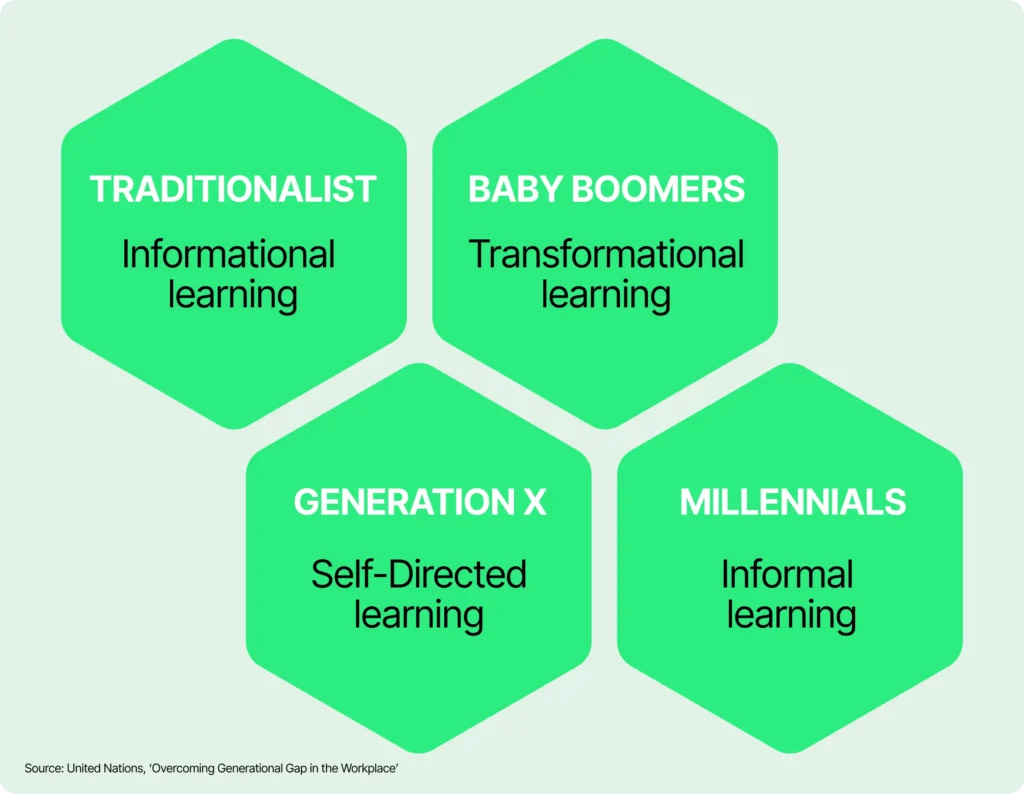- Training
Are You Ready To Support Four Generational Learning Styles?

For the first time in modern history, organizations have been tasked with supporting employees spanning four generational learning styles.
For reasons of health, economy, interest, and more, employees are delaying retirement while ever more new employees come on board — and the resulting mix is creating a new challenge for teams charged with organizational learning.
Large organizations today employ team members who clearly remember the days of black and white television and rotary phones, and seat them just a cube away from recent graduates who’ve never known a world without the internet or email.
Of course, while much is made of generational differences, people of every age tend to share more similarities than differences. Still, for organizational communicators, HR representatives, and Learning and Development teams, there are a few noteworthy distinctions in how the 4 generations at work in offices today learn most comfortably.

The learning styles of the four generations at work
Much research has been done as to how to organizations can best teach members of each generation. Most often, the resulting reports break down learning styles on a continuum from formal to informal. Shown above is the United Nations’ adaptation of the model, as developed with Deloitte and Touche.
Let’s look more closely at the common learning styles for each generation:
Traditionalists — Born before 1945, traditionalists tend to favor a more structured, “command and control” oriented learning program. Classroom lectures are often preferred. As more experienced members of the team, members of this generation may also be ideal mentors in select roles and organizations.
Baby Boomers — Born between 1946 and 1964, baby boomers expect a more personally-focused learning structure. The classroom continues to be an effective setting, although members of this generation tend to favor in-class participation, reflection, and feedback to bring them more directly into the process.
Generation X — Born between 1965 and 1980, the members of Gen X are often noted as the most fiercely independent of the 4 groups, prioritizing self-directed educational opportunities and programs that enable them to learn on their own schedule.
Millennials — Born after 1980, this latest generation to enter the workforce has married the learning preferences of its two predecessors, favoring highly personalized training on a self-directed schedule. As the members of Gen Y grew up with the internet, it should be no surprise this cohort also prefers to access information on-demand, whenever and wherever they may happen to want it.
Is your learning organization able to support four generations’ learning styles?
While developing organizational training programs to meet the needs of all four generations working in your company may seem like an impossible task, it doesn’t need to be. With the right technology, you can add introduce flexibility to your learning structure, and create a scalable way to share a single message in a way that meets the needs of every employee.
Video can be the platform that supports the way your people learn — no matter their individual style.
Organizations worldwide are already using video to supplement and scale their Learning and Development programs. This helps deliver more engaging training to global, regional, and front-line offices, reduce costs associated with travel, events, and AV production, and even curate and save institutional knowledge to mitigate expertise lost due to turnover.
Let’s look at how leading businesses today are using video to meet the needs of all four generational learning styles.
Traditional, Formal Classrooms — Video offers tremendous potential for learners favoring this environment, not by changing the content, but by making it scale. Simply recording a classroom training session and making it available on the “corporate YouTube” extends the reach of a physical session to anyone around the world who wouldn’t otherwise be able to attend. This can be an easy way for companies to mitigate costs by reducing the sheer amount of travel required of trainers. It can also be an effective way to extend a conference or other event for attendees worldwide, as Siemens has shown.
Watch a recording of a live training session below:
Interactive, Personalized Classes — Along with simply presenting information, modern video learning tools can also offer learners a chance to participate. Some modern video platforms like Panopto enable viewers to leave comments or ask questions inside a recording, for the presenter to respond to. Presenters can also embed interactive content like quizzes inside video, to further personalize the experience.
Watch a compliance training video captured with Panopto:
Self-Directed Learning — Not only can video be used to capture individual or classroom-based events to be shared at a specific time, it’s also an ideal tool for creating on-demand self-paced courses. New manager training, in-depth product reviews, comprehensive sales strategy discussions and dozens of other ideas can be effectively taught in this format. As more and more organizations seek to extend training beyond the basics, this kind of course is an ideal way to teach a series of related ideas that may be relevant to only a few learners at a time — not in enough demand to warrant a full classroom session, but certainly essential for helping your people work their best.
Watch an on-demand training video from our library below:
On-Demand Informal Knowledge Sharing — Along with enabling Learning and Development teams to support and scale more traditional training efforts, today organizations are extending video to help capture and share institutional expertise. Such social learning has been at practice in virtually every organization since the dawn of time, as colleagues tap internal subject matter experts for quick insights on how and why systems and processes work the way they do. Historically, though, such learning was limited by availability — if your expert was in a meeting, out of the office, or no longer with the company, the answer wasn’t available. Video solves that challenge — recording the expert answer and making it available on the company YouTube both ensures your people get the right answers, right when they need them, and that those answers don’t just walk out the door with your employees. Many organizations find that, although social learning may be adopted to suit the needs of Millennials, the opportunity to share wisdom with others is appreciated by employees of every generation.
Watch a knowledge-sharing video from one of our engineers below:
Today video has become a single tool that organizations around the world are applying to support the learning needs of all four generations inside the office. Is your organization doing everything it can to help ensure everyone’s learning needs are met?
Learn more about motivating Millennials.
In this paper, you’ll learn how your organization can support video to help your next generation of employees succeed.



